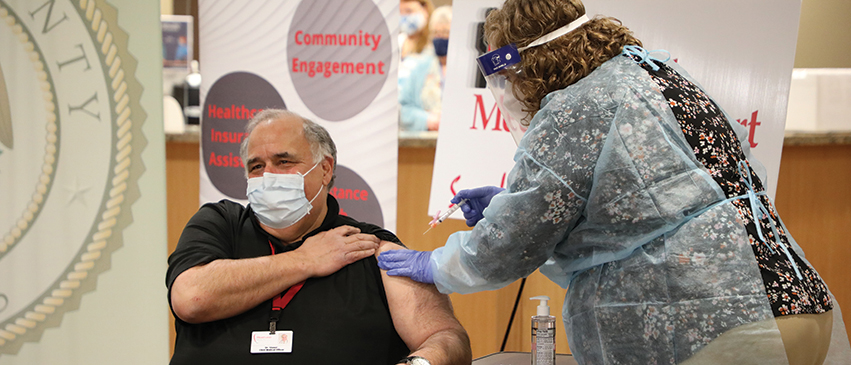Roll Up Your Sleeve

As I write this, the Peoria City/County Health Department—in partnership with Tazewell County Health Department, Woodford County Health Department, OSF Saint Francis Medical Center and UnityPoint Health—has been working to provide over 9,000 COVID-19 vaccines to Phase 1A of the state’s vaccination plan. Our staff, like hundreds of local health department professionals, have set up clinics and begun providing this opportunity in our communities. Here in Peoria, we are using Heddington Oaks to provide a safe way to get vaccines.
By the time you read this in February, we will have dispensed to our local healthcare providers—those who work as paramedics, nurses, physicians, dentists, pharmacists and technicians, home health workers, dialysis techs, cancer center staff, and more. I am encouraged by the sheer number of people who have reached out—not just from the healthcare community, but the general public—and are eager to roll up their sleeves and be immunized.
Vaccines are now starting to arrive in our community, and it is a relief in so many ways. It is a relief that Pfizer and Moderna were able to develop a safe vaccine so quickly; a relief that it is making its way down the supply chain to our community; and a relief that we can begin to see the end of this pandemic.
But I would caution all of us not to get complacent. The vaccine, so far, is not in everyone’s arms. To really stop this pandemic, we must continue to use all the tools in our toolbox—including wearing a mask, keeping a social distance when out in public, and washing our hands frequently. Now we have another tool—a safe and effective one: the COVID-19 vaccine.
The current vaccines available for COVID-19 are known as mRNA vaccines, which prime your immune system so it will be ready to fight the virus if you are exposed. This is a new type of vaccine, but not new to science.
To trigger an immune response, many vaccines utilize a weakened or inactivated virus in the injection. This is what many of us typically think of when we think of how vaccines work, but mRNA vaccines are different. Instead, they teach our cells how to make a protein—or even just a piece of a protein—that triggers an immune response inside our bodies. Think of it as giving your body a “blueprint” of a virus, and not the virus itself. Your body will then have an immune response, producing antibodies. That is what protects us from getting infected if the real virus enters our bodies.
Here’s what we know about the COVID-19 vaccine:
- Clinical trials have shown the approved COVID-19 vaccines are both safe and effective. Vaccine manufacturers tested the vaccine across many groups of people from all walks of life. What used to take years to produce a vaccine was done in months, and with no shortcuts on safety.
- You will need two doses of the vaccine. All the trials showed that the vaccines help prevent upwards of 90 percent of disease just a few weeks after your second vaccine.
- If you’ve had a positive COVID-19 test, you still need a vaccine. Having had the disease may provide some natural protection or immunity, but experts don’t know how long this protection lasts. Vaccination has shown a much higher antibody response than you would get even after having the sickness.
My advice to everyone is roll up your sleeve and take the COVID-19 vaccine when it is offered to you, and encourage others to do the same. It’s only by utilizing all of the tools in our toolbox—handwashing, social distancing, mask wearing, and now getting a safe vaccine—that we’ll get back to normal. Let’s end this pandemic together. PM
Monica Hendrickson, MPH, is public health administrator for the Peoria City/County Health Department.
- Log in to post comments

